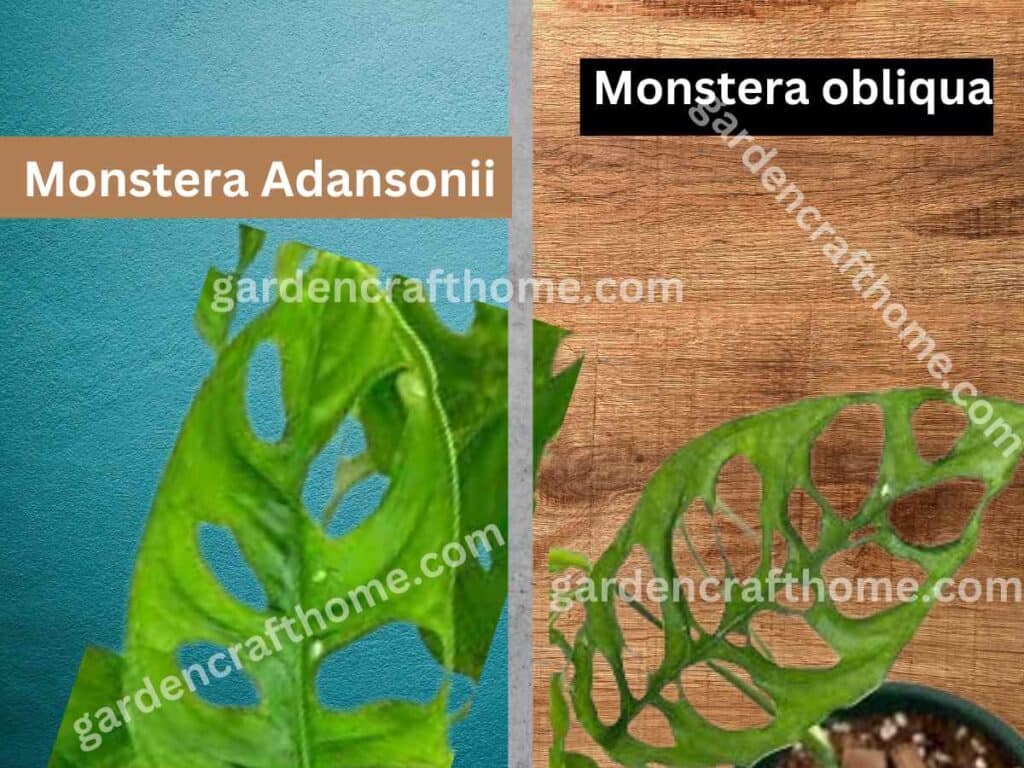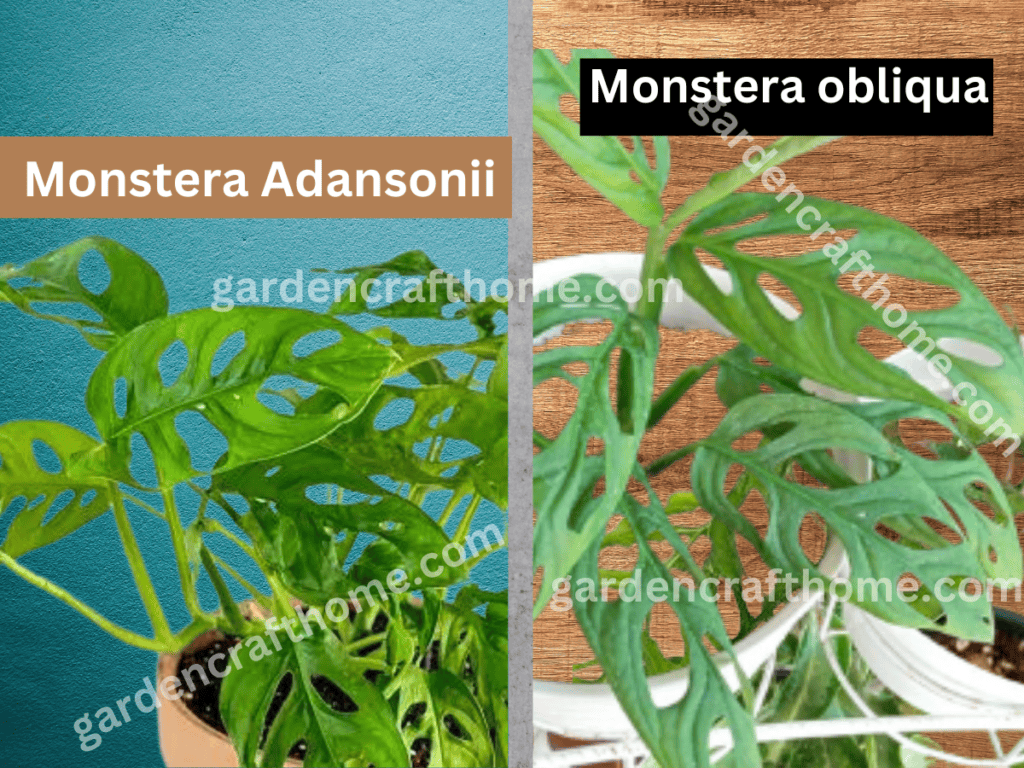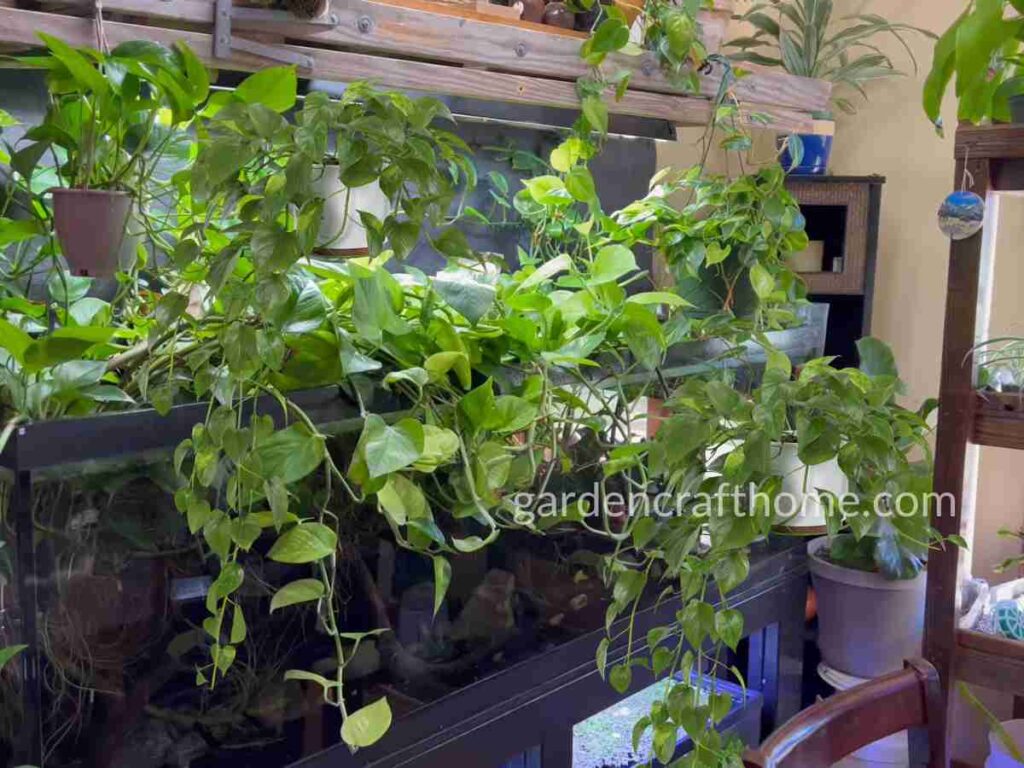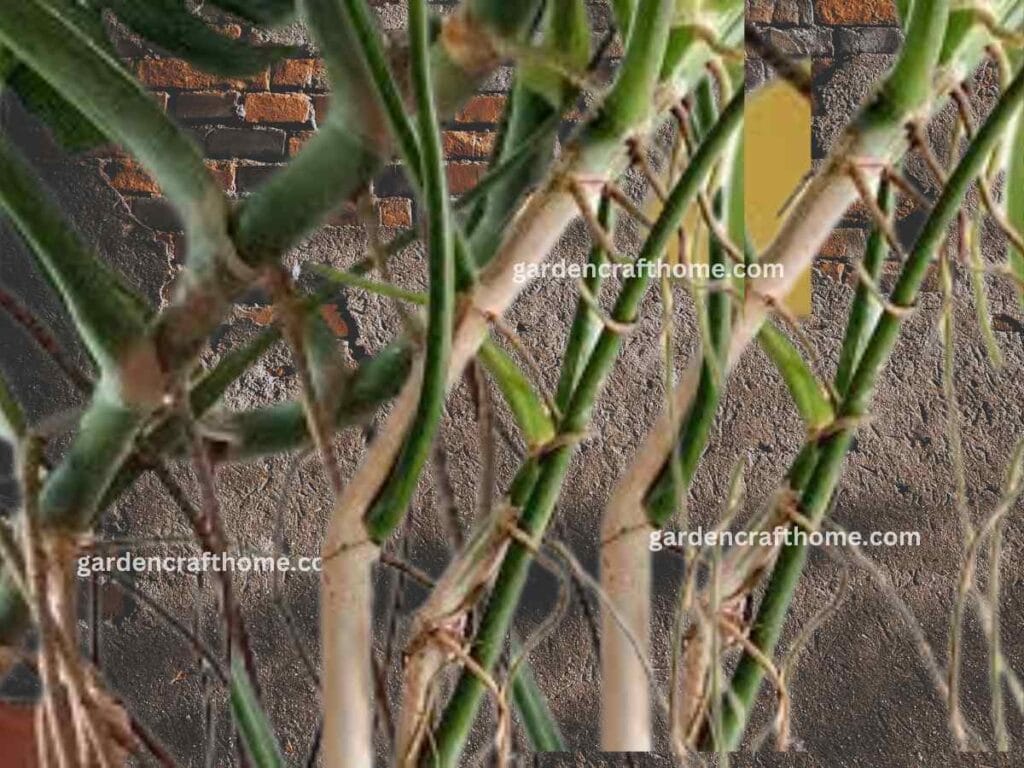Difference Between Monstera Adansonii And Obliqua: Monstera obliqua is considered the Holy Grail among Monstera plants. Still, its need has led to much confusion for Monstera adansonii.
Monstera Obliqua’s need has led to many fakes in advertising in the market.
In this article, I will give you the 9 Ways To Distinguish Monstera Adansonii From Obliqua and help you identify which one you have.
Let’s start with something very simple that can give you an idea of whether you are dealing with an adansonii or an obliqua.
If interested, click here to learn how to reproduce the Monstera plant from seed.
The Difference Between Monstera Adansonii And Obliqua Shape Of Leaf Hole
The main differences between Monstera obliqua and monstera Adansonii are the number of holes, shape, and size.
The shape and size of the holes, also known as leaf fenestrations, is another easy way to distinguish between Monstera adansonii and Monstera obliqua.

The genus Monstera is commonly known as the Swiss cheese plant due to the series of holes of different sizes found in its foliage.
It is, without a doubt, what draws the most attention to both plants. Also, what usually causes confusion between Monstera obliqua and Adansonii in their holes?
Monstera adansonii tends to have smaller, narrower fenestrations, almost like slits rather than holes, especially when younger.
You will see that it combines longer and wider holes with smaller ones.
Even when it matures, its fenestrations never grow very large. They are longer than wide and complemented by smaller holes in each leaf.
On the other hand, Monstera obliqua has enormous fenestrations. You would be hard-pressed to find a Monstera species with larger fenestrations than Monstera obliqua.
In the case of the obliqua, its fenestrations are tremendous, to the point that the blade is only composed of the children of the holes it generates.
This makes their leaves very fragile, which must also be maintained for photosynthesis (hence, you have to be very careful).
The perforations are so large that some say the obliqua has more open space than the blade, which is often true.
The leaves are extremely fragile due to their small size.
Importantly, even Monstera obliqua must grow to achieve its fenestrated form.
You probably won’t see these larger-than-normal holes until the plant has matured or is close to that point.
The great originality of both monsteras is that they have leaves with a different pattern from the popular monstera delicious.
Their major attractiveness is that they are perforated naturally. Almost all of the leaves of Monstera obliqua are punctured.
A natural pattern that sometimes causes the leaf to be composed of tiny green threads that even break the edge of it.
The picture for the monstera Adansonii is distinctive. There are holes, but they are built into the blade.
The monstera obliqua seems attacked by an army of snails, Taking it to flatter terrain. At the same time, the Adansonii is just a clueless slug.
The Difference Between Monstera Adansonii And Obliqua Leaves Thicknesses
Leaf thickness is a more subtle difference, and you need to have Monstera obliqua and Adansonii plants.
Leaf thickness is noticeable with a simple glance but much more so if we touch its leaves.
- Have you ever touched a Monstera adansonii leaf? Monstera adansonii, probably due to its size, has thicker leaves with a leathery, rough texture.
- However, in the case of the oblique, if you touch one of these sheets, it will seem as if you are touching paper.
They are so thin and delicate that if you press too hard, they can easily break, so it is better not to touch them for a long time and without using much force.
In summary, Monstera obliqua has leaves with a thickness comparable to that of paper.
The monstera Adansonii, for its part, has a somewhat coarser and rougher texture—nothing like touching one and the other to realize this aspect.
The Difference Between Monstera Adansonii And Obliqua Length
It is important to note that this difference will only be evident in mature plants since the leaves are smaller when they are young or still growing.
It will be more difficult to use this leaf size reference to differentiate them.
However, once the plants reach maturity, the sizes will be very different.
The leaf of Monstera obliqua is not particularly large, and its average size is 10 centimeters to 25 centimeters.
On the other hand, the Monstera adansonii leaf is much larger, measuring between 50 and 75 centimeters at maturity.
The Difference Between Monstera Adansonii And Obliqua Leave the shape
The leaves of Monstera obliqua are lanceolate. Or, put another way, in the shape of a spear.
Additionally, they are similar to Monstera delicious in that they are a good size.
However, the Monstera Adansonii has smaller, rounded leaves on its sides.
The Difference Between Monstera Adansonii And Obliqua Leaf Edges
The edge of the leaves is Another difference between Monstera adansonii and obliqua. It is not discussed very well, but you can notice it a little to the touch.
As for the edges of the leaves, you may notice that Monstera adansonii has straight edges.
In contrast, the edges of Monstera obliqua have a slightly wavy shape.
You see, in the case of adansonii, the edges of the leaves are straight, but not so in the obliqua, which usually have a somewhat wavy shape.
You can see this better if you take the sheet without much force and place it horizontally to see if the edge runs straight along it or notice a certain undulation along the line.
Of course, be careful with the blade; do not break it due to the fenestrations.
The Difference Between Monstera Adansonii And Obliqua Growth Rates
Growth speed is another way to distinguish between Monstera adansonii and Monstera obliqua.
If you’re still confused about which of your Monsteras is the adansonii or the obliqua, measure how fast it grows.
Monstera obliqua grows very slowly, making it rare, as fewer plants exist.
On the other hand, Monstera adansonii grows quickly and will stand out for its rapid growth. In one month, it is not uncommon for the adansonii to grow up to one meter.
Monstera adansonii is a very fast-growing plant. It is said that if you give it the necessary care, it can reach one meter in just a month: we assume this will not happen in a pot but will grow quite a bit.
Are you interested? Click here to learn how to care for Monstera Adansonii.
Monstera obliqua also grows but at its own pace. That pace is very, very slow, even agonizingly slow.
Even in its natural habitat, where the plant has all it needs to flourish, it might take years to see the obliqua grow several meters.
Of course, I must remind you that plant growth rate is not guaranteed. You must provide suitable conditions for the plant in your home or office.
If you do and you are growing an adansonii, the plant will reward you with rapid and generous growth.
The obliqua won’t do it. This can make caring for this plant even more frustrating despite its rarity.
If interested, click here to learn how to propagate a Monstera plant. [Link]
The Difference Between Monstera Adansonii And Obliqua Stolons
The presence or absence of stolons is another factor that will help you determine if you have a Monstera adansonii or a Monstera obliqua.
However, it will only appear if you properly care for the plant. If not, it will not help you distinguish one from the other.
But what is stolen? It is the name given to the horizontal stems in which adventitious roots develop.
Sometimes, they can also grow underground where you can’t see them.
From a stolon in the nodule, a series of adventitious roots develop.
These roots can appear on plants without stolons when the plant is stressed. However, adventitious roots are part of regular growth in a plant with a stolon.
Only Monstera obliqua develops stolons, and adansonii does not have these, so it can be definitive to know which species you have.
If you don’t see these horizontal roots on your Monstera, you have an adansonii. This species is not known to develop stolons.
also, read How To Build A Cinder Block Planter Box
Inflorescence And Flowers Difference Between Monstera Adansonii And Obliqua
A distinctive difference between Monstera adansonii and Monstera obliqua is the inflorescence, the number of flowers on the spadix.
One of the classic characteristics of the oblique inflorescence is the very small number of flowers on the spadix. By comparison, it is easy to see how they are completely different.
The Monstera genus belongs to the Araceae plant family, commonly known as the aroid plant family, and they all have similar inflorescences.
Aroid inflorescences consist of a spathe (which resembles a hood and is a shining leaf) and the spadix, the long, conical growth in the middle.
The flowers are very small and appear on the spadix.
That’s why what we think of as a “flower” is more correctly called an inflorescence, the spathe + spadix. The actual flowers appear tiny and on the spadix.
The main problem with this method of differentiating the Adansonii and the Oblicua is that the chances of a Monstera flowering inside the house are very slim.
Although the difference in inflorescence is key, we must consider other differences, as very few typically flower indoors.
Distinguish Monstera Adansonii From Obliqua By Prices
The final difference between Monstera Obliqua and Monstera Adansonii is cost; you will most likely see a big difference here.
A Monstera Obliqua is difficult to find, and if you do find it, it will cost you much more than a common houseplant that can easily be found at your local plant store or nursery.
Monstera obliqua is very, very expensive. Remember that its growth is quite slow, with fewer natural specimens. Therefore, they charge more for them.
On the other hand, adansonii are cheaper, much cheaper.
At a minimum, you will pay 100 euros/dollars, or the equivalent in another currency, for a real Monstera Obliqua.
Depending on the size and number of leaves, a price of 250 dollars/euros or more can be considered for these slow-growing plants.
On the other hand, Adansonii is priced similarly to most other common houseplants. Depending on Monstera Adansoni’s size, you can expect to pay between 15 and 30 euros or dollars.
Note: it is common to find Monstera adansonii sold as obliqua in stores.
Due to a lack of knowledge between the species, we often find that adansonii is sold to us as obliques or, on the contrary, obliqua as adansonii.
Conclusion
Monstera obliqua vs. adansonii, you should now be able to distinguish monstera adansonii from obliqua
As you can see, comparing and identifying these Monsteras is easier when they are already mature.
As far as we know, there are no more differences between Monstera adansonii and obliqua.
It can be difficult or impossible to tell which one it is when the plant is still young.
Therefore, we recommend that you try to see as many images as possible about both plants.
I hope this article has been useful. Do not hesitate to read similar articles concerning Monstera.
More posts about Monstera. [Link]





